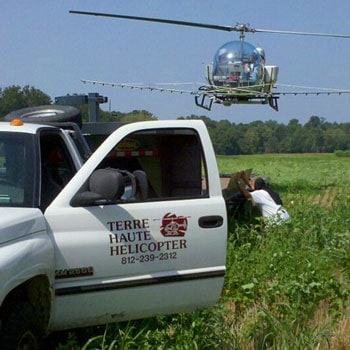I self-trained myself to fly Ag (agricultural spraying). It was a dangerous and risky undertaking. I did this by purchasing an old Brantly B2B helicopter, originally to give rides. I hung out at a local convenience store, wore a flight suit and asked patrons if they wanted to go for a helicopter ride. I then purchased an old Bell 47 w/spray rig and acquired my Part 137 certificate. I then acquired my Part 91.147 LOA and began doing fairs and festivals. After my wife wrecked my 47, I purchased a 206 Jet Ranger w/GPS & spray equipment. I spray “row crops” corn, beans wheat and some aquatic herbicide work.
With the Brantly, we started pollinating corn this past season. I also lease out the Brantly for pilots looking to build time, (it’s half the cost of a R22), and do Ag flight training in the Brantly. This includes knap of the earth flying, riverbed, un-natural approaches, obstacle avoidance, confined take-off and landings, 360 degree slopes, escapes, flying around and under powerlines and towers. I also include instruction emphasizing safety beyond the aircraft. There is a lot of pressure in the “real world” to fly beyond your comfort and safe level. Customers and management alike are primarily interested in profits. Young pilots are extremely susceptible to being forced into conditions that are not safe.
Flying one summer with me was very beneficial in Sam Mohring securing a job with PHI in Louisiana. He gained a little turbine time in the 206 and knap of the earth experience. I mentored Brooke Preston last year. He was just hired last week to fly a Bell 47 doing Ag work this summer. He has less than 700 hrs.
I just completed application for a Part 135 certificate. I have flown one Nascar Race SIC and gained a contact to lease out for events in the Midwest. I expect to have that certificate by mid-summer.
Yes, low-level, environment with a large amount of obstructions. All contour flying. All take-offs are max performance max capacity, the majority of take-offs and landings are confined and many of those are slope, all are soft surface (grass, fields, gravel, field stubble, white rock, etc.) Landing on a trailer.
Cara. She’s a doll. I was very pleased with the level of training, flying in different aircraft, realizing the same model and series helicopters can have very different flight characteristics. Training with a few different instructors, (although 99% of my flights were with Matt, I did fly with Kojie, Noah and Ben (FAA). Each were a little different in their approach and attitude. The weather is a great benefit to training. I don’t remember ever flying on a calm day. Those winds definitely improved my skills and comfort level flying. The ability to fly in mountainous terrain was also a great benefit to my being hired for my first job, (tour pilot Bell 47 Badlands Helicopters).
I would, I do, and I have. If every person that I recommended MLH to called them, they’d need a full time answering service.


